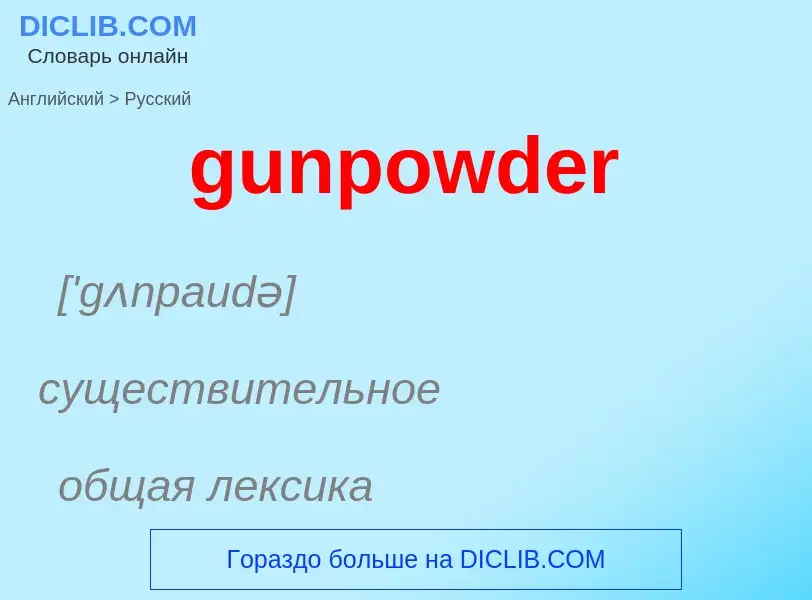Перевод и анализ слов искусственным интеллектом ChatGPT
На этой странице Вы можете получить подробный анализ слова или словосочетания, произведенный с помощью лучшей на сегодняшний день технологии искусственного интеллекта:
- как употребляется слово
- частота употребления
- используется оно чаще в устной или письменной речи
- варианты перевода слова
- примеры употребления (несколько фраз с переводом)
- этимология
gunpowder - перевод на русский
['gʌnpaudə]
существительное
общая лексика
чёрный порох
черный порох
Определение
Википедия

Gunpowder, also commonly known as black powder to distinguish it from modern smokeless powder, is the earliest known chemical explosive. It consists of a mixture of sulfur, carbon (in the form of charcoal) and potassium nitrate (saltpeter). The sulfur and carbon act as fuels while the saltpeter is an oxidizer. Gunpowder has been widely used as a propellant in firearms, artillery, rocketry, and pyrotechnics, including use as a blasting agent for explosives in quarrying, mining, building pipelines and road building.
Gunpowder is classified as a low explosive because of its relatively slow decomposition rate and consequently low brisance. Low explosives deflagrate (i.e., burn at subsonic speeds), whereas high explosives detonate, producing a supersonic shockwave. Ignition of gunpowder packed behind a projectile generates enough pressure to force the shot from the muzzle at high speed, but usually not enough force to rupture the gun barrel. It thus makes a good propellant but is less suitable for shattering rock or fortifications with its low-yield explosive power. Nonetheless, it was widely used to fill fused artillery shells (and used in mining and civil engineering projects) until the second half of the 19th century, when the first high explosives were put into use.
Gunpowder is one of the Four Great Inventions of China. Originally developed by the Taoists for medicinal purposes, it was first used for warfare around 904 AD. Its use in weapons has declined due to smokeless powder replacing it, and it is no longer used for industrial purposes due to its relative inefficiency compared to newer alternatives such as dynamite and ammonium nitrate/fuel oil.


![1840 drawing of a [[gunpowder magazine]] near [[Tehran]], [[Persia]]. Gunpowder was extensively used in the [[Naderian Wars]]. 1840 drawing of a [[gunpowder magazine]] near [[Tehran]], [[Persia]]. Gunpowder was extensively used in the [[Naderian Wars]].](https://commons.wikimedia.org/wiki/Special:FilePath/Barout khaneh near Tehran by Eugène Flandin.jpg?width=200)

.jpg?width=200)
![Earliest depiction of a European cannon, "De Nobilitatibus Sapientii Et Prudentiis Regum", [[Walter de Milemete]], 1326. Earliest depiction of a European cannon, "De Nobilitatibus Sapientii Et Prudentiis Regum", [[Walter de Milemete]], 1326.](https://commons.wikimedia.org/wiki/Special:FilePath/EarlyCannonDeNobilitatibusSapientiiEtPrudentiisRegumManuscriptWalterdeMilemete1326.jpg?width=200)
![The Hagley Museum]] The Hagley Museum]]](https://commons.wikimedia.org/wiki/Special:FilePath/Hagley Mill Equipment.jpg?width=200)

![Gunpowder storing barrels at the [[Martello tower]] in [[Point Pleasant Park]], [[Halifax, Nova Scotia]], Canada Gunpowder storing barrels at the [[Martello tower]] in [[Point Pleasant Park]], [[Halifax, Nova Scotia]], Canada](https://commons.wikimedia.org/wiki/Special:FilePath/Martello Tower barrels.jpg?width=200)
![[[Mughal Emperor]] [[Shah Jahan]], hunting deer using a [[matchlock]] [[Mughal Emperor]] [[Shah Jahan]], hunting deer using a [[matchlock]]](https://commons.wikimedia.org/wiki/Special:FilePath/Meister der Shâh-Jahân-Nâma-Memoiren 001.jpg?width=200)
![A 'flying-cloud thunderclap-eruptor' firing thunderclap bombs from the ''[[Huolongjing]]'' A 'flying-cloud thunderclap-eruptor' firing thunderclap bombs from the ''[[Huolongjing]]''](https://commons.wikimedia.org/wiki/Special:FilePath/Ming Dynasty eruptor proto-cannon.jpg?width=200)
![Gunner of [[Nguyễn dynasty]], [[Vietnam]] Gunner of [[Nguyễn dynasty]], [[Vietnam]]](https://commons.wikimedia.org/wiki/Special:FilePath/Pháo thủ.jpg?width=200)
![annex]] the territories of the [[Sultanate of Mysore]], during the [[Second Anglo-Mysore War]]. The British battalion was defeated during the [[Battle of Guntur]], by the forces of [[Hyder Ali]], who effectively used [[Mysorean rockets]] and [[rocket artillery]] against the closely massed British forces. annex]] the territories of the [[Sultanate of Mysore]], during the [[Second Anglo-Mysore War]]. The British battalion was defeated during the [[Battle of Guntur]], by the forces of [[Hyder Ali]], who effectively used [[Mysorean rockets]] and [[rocket artillery]] against the closely massed British forces.](https://commons.wikimedia.org/wiki/Special:FilePath/Rocket warfare.jpg?width=200)
![[[Flash pan]] starter dispenser [[Flash pan]] starter dispenser](https://commons.wikimedia.org/wiki/Special:FilePath/Zündkraut mit Zündkrautspender.jpg?width=200)
